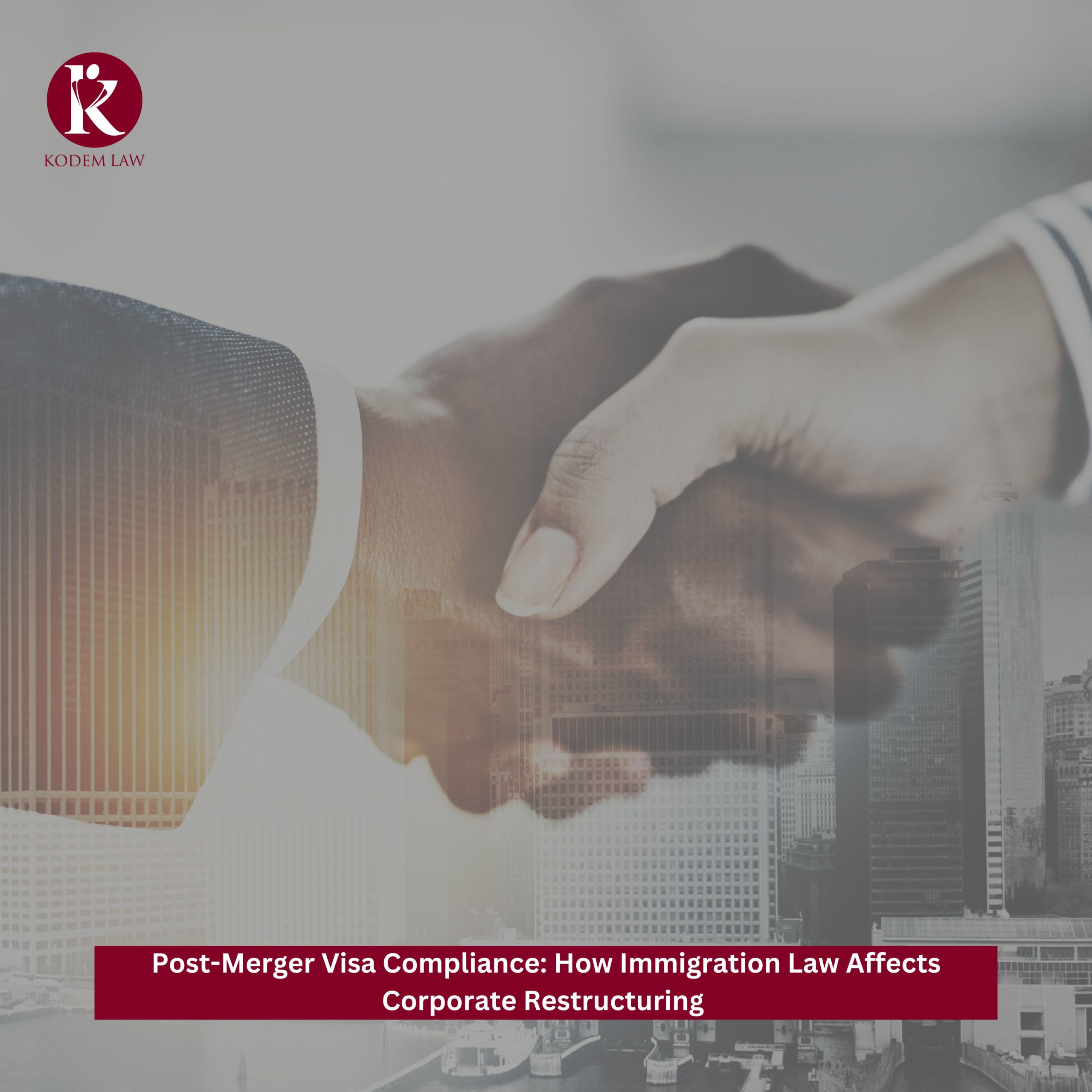
The complex landscape of corporate mergers and acquisitions (M&A) involves navigating various factors, with visa compliance being a crucial yet often overlooked element. Effectively managing the immigration status of the workforce during restructuring is vital, as it influences operational stability, employee morale, and the overall success of the newly formed organization. Neglecting immigration issues can lead to significant legal risks and operational challenges, particularly in today’s global economy, where talent mobility is essential for competitiveness.
This article provides insights into the importance of post-merger visa compliance and offers practical guidance for organizations to manage immigration issues effectively. By prioritizing these aspects, businesses can ensure a smoother integration process, enhance workforce stability, and ultimately achieve long-term success in a dynamic marketplace.
Visa Compliance After a Merger or Acquisition: Why It Matters
- Critical Aspect of M&A: Mergers and acquisitions present opportunities for growth but often overlook visa compliance, which is essential for organizational stability.
- Legal Obligations: Compliance with immigration laws is necessary to avoid fines, penalties, and lawsuits. Non-compliance can lead to serious legal ramifications for the acquiring company.
- Employee Retention: M&A can create uncertainty for employees, especially those on work visas. Clear communication about visa status helps maintain morale and retain talent during transitions.
- Operational Efficiency: Valid visa statuses are crucial for smooth operations. Expired or invalid visas can disrupt the workforce, leading to decreased productivity and lost efficiency.
- Reputation Protection: A commitment to visa compliance strengthens a company’s reputation. Non-compliance can damage relationships with clients, partners, and investors.
- Facilitates Integration: Managing diverse visa statuses promotes a smoother transition during M&A. Addressing compliance fosters a cohesive corporate culture and makes employees feel secure.
Understanding the Impact on Different Visa Categories
When a merger or acquisition occurs, the implications for various visa categories can be significant. Each type of visa has unique requirements and processes that must be navigated carefully to ensure compliance and minimize disruption. Here’s an overview of how M&A can affect key visa categories:
1. H-1B Visa
- Overview: The H-1B visa allows U.S. companies to employ foreign workers in specialty occupations.
- Impact: Changes in company structure can affect the employer’s ability to sponsor H-1B employees. Employers must file new H-1B petitions to reflect the new company name or structure. Additionally, layoffs or changes in job roles may jeopardize the visa status of H-1B employees.
2. L-1 Visa
- Overview: The L-1 visa is for intra-company transferees who work for a multinational company.
- Impact: A merger or acquisition may complicate L-1 visa status if the new entity has different operational structures or functions. Companies need to ensure that L-1 employees meet the requirements, especially regarding managerial or specialized knowledge roles. Merging entities may also need to reassess the employee’s position to comply with L-1 criteria.
3. O-1 Visa
- Overview: The O-1 visa is for individuals with extraordinary ability in their field, such as arts, sciences, business, or athletics.
- Impact: O-1 visa holders may face scrutiny if their roles or projects change significantly due to a merger. Companies must demonstrate that the employee’s extraordinary abilities are still needed and aligned with the new organizational goals, which may require updated petitions or supporting evidence.
4. E-2 and E-1 Visas
- Overview: The E-2 visa is for investors from countries with a treaty with the U.S., while the E-1 visa is for treaty traders.
- Impact: Changes in ownership or control resulting from a merger or acquisition can affect E-2 and E-1 status. Companies must ensure that the investment and trading operations comply with visa requirements, which may involve filing new applications or amendments to existing visas.
5. PERM Process and Green Card Sponsorship
- Overview: The PERM process is the first step for employers to sponsor foreign workers for permanent residency (green cards).
- Impact: M&A can impact ongoing PERM applications and green card sponsorship. If a company undergoes significant structural changes, it may need to restart the PERM process for affected employees or reassess the labor market conditions. Compliance with recruitment and advertising requirements must also be maintained throughout the process.

Key Steps to Ensure Post-Merger Visa Compliance
Ensuring visa compliance after a merger or acquisition is essential for protecting the immigration status of employees and mitigating legal risks. Here are the key steps organizations should take to ensure compliance:
1. Conduct an Immigration Audit: Conducting an immigration audit is essential for reviewing the immigration status of all employees, especially those on work visas, to identify compliance gaps or issues. This process involves assessing the validity and expiration dates of documentation and ensuring alignment with current employment roles. The audit should encompass all visa categories impacted by the merger to ensure comprehensive compliance.
2. Assess “Successor-in-Interest” Status: The purpose of evaluating whether the acquiring company qualifies as a “successor-in-interest” for employees holding work visas is to determine obligations concerning existing visa petitions. This involves assessing the extent of business continuity and the relationship between the two companies, which clarifies whether these petitions need to be transferred or amended.
3. File Amendments or New Petitions: Address any changes in company structure or employee roles that affect visa status. Depending on the results of the immigration audit and successor-in-interest analysis, file amendments for existing visas or new petitions as required. Ensure that all petitions reflect the correct company name and structure.
4. Review Green Card Sponsorships: Reviewing green card sponsorships is crucial to reassess ongoing processes considering the merger. This involves examining the status of PERM applications to ensure compliance with recruitment and labor market requirements, as well as determining whether any new applications need to be filed due to changes in company ownership or operations.
5. Notify Employees
- Purpose: Keep employees informed about their immigration status and any changes that may affect them.
- Actions: Communicate clearly with employees regarding their visa status, any required actions they need to take, and the support the company will provide. This communication helps alleviate concerns and fosters a sense of security during the transition.
Note: By following these key steps, organizations can effectively navigate the complexities of post-merger visa compliance. Proactive measures not only protect the immigration status of employees but also support a smoother integration process, ultimately contributing to the success of the merged entity.
Risks of Non-Compliance: Post-Merger Visa Compliance
Failing to address visa compliance during and after a merger or acquisition can expose organizations to various risks that can have serious implications for their operations, reputation, and financial stability. Here are some key risks associated with non-compliance:
1. Legal Consequences
- Fines and Penalties: Organizations that fail to comply with immigration laws can face significant fines and penalties, which vary based on the severity of the violation.
- Lawsuits: Non-compliance may lead to lawsuits from employees or government agencies, resulting in costly legal fees and potential settlements.
2. Employee Displacement
- Loss of Talent: Employees with work visas may be forced to leave the company if their visa status is jeopardized. This loss can disrupt operations and lead to a decline in productivity.
- Low Morale: Uncertainty about immigration status can create anxiety among employees, leading to decreased morale and engagement, which can negatively impact overall company culture.
3. Operational Disruption
- Workflow Interruptions: Disruptions in the workforce due to visa issues can hinder day-to-day operations, delaying projects and affecting client relationships.
- Increased Turnover: The risk of turnover among key personnel can increase, requiring organizations to spend time and resources on recruitment and training new employees.
4. Reputational Damage
- Brand Impact: Non-compliance can damage a company’s reputation, resulting in negative publicity that can affect client and partner relationships.
- Loss of Trust: Stakeholders, including investors and clients, may lose confidence in an organization that does not prioritize legal and ethical compliance.
5. Financial Implications
- Increased Costs: Legal fees, fines, and the costs associated with hiring and training new employees can add up quickly, straining the organization’s financial resources.
- Impact on M&A Value: Non-compliance can affect the perceived value of the merger or acquisition, impacting negotiations and future growth potential.
Leveraging Legal Counsel for Immigration Compliance
Navigating the complexities of immigration laws and regulations during a merger or acquisition requires specialized knowledge and expertise. Leveraging legal counsel is essential to ensure compliance and mitigate risks associated with visa issues. Here’s how legal counsel can play a vital role in achieving immigration compliance post-merger:
- Kodem Law provides expert guidance on immigration regulations and visa categories to ensure compliance during mergers and acquisitions.
- We conduct thorough compliance audits to assess workforce visa documentation and develop strategies to address any gaps.
- Our team prepares and submits necessary visa petitions for affected employees, ensuring timely filings to maintain their visa status.
- We identify potential compliance risks and offer crisis management strategies for any issues that arise.
- We provide training for HR and management on immigration compliance best practices and assist in creating tailored immigration policies.
- Our ongoing support includes continuous monitoring of immigration compliance and advisory services for visa renewals and employee transitions.
Key Considerations for Future Corporate Changes
When planning for future corporate changes, such as mergers, acquisitions, or restructurings, it’s crucial to consider various factors that can impact immigration compliance and overall organizational effectiveness. Here are some key considerations to keep in mind:
1. Integration of Compliance Practices
- Streamlining Processes: Develop standardized immigration compliance practices across the organization to ensure consistency during future changes.
- Best Practices: Adopt best practices for visa management, including regular audits and updates to ensure that all employees maintain valid immigration statuses.
2. Employee Communication
- Transparent Communication: Establish clear channels for communicating with employees about how corporate changes may affect their immigration status and employment.
- Support Resources: Provide access to resources and legal counsel for employees to address their concerns and questions regarding immigration issues during transitions.
3. Long-Term Workforce Planning
- Talent Retention Strategies: Identify and implement strategies to retain key talent, especially those with work visas, to avoid disruptions in operations and maintain competitive advantage.
- Succession Planning: Consider how corporate changes may impact talent pipelines and succession planning, ensuring that critical roles remain filled.
4. Legal and Regulatory Awareness
- Stay Informed: Regularly update legal counsel on changes in immigration laws and policies that may affect the organization’s workforce.
- Proactive Measures: Take proactive steps to adapt to new regulations, including modifying policies and procedures as necessary to maintain compliance.
5. Cultural Considerations
- Diversity and Inclusion: Promote a diverse and inclusive workplace by valuing the contributions of employees from different backgrounds, particularly in the context of mergers or acquisitions.
- Cultural Integration: Address cultural differences that may arise during corporate changes, facilitating smooth integration and collaboration among diverse teams.
6. Assessment of Corporate Structure
- Evaluate Structure: Assess the impact of corporate changes on the organizational structure and how this may affect visa sponsorship and compliance.
- Flexibility in Operations: Build flexibility into the corporate structure to accommodate future changes in immigration laws or workforce needs, allowing for quick adjustments when necessary.
7. Continuous Training and Development
- Training Programs: Implement training programs for HR and management teams to keep them informed about immigration compliance issues and legal requirements.
- Leadership Development: Focus on developing leaders who understand the importance of compliance and can navigate the complexities of immigration laws during corporate changes.
Conclusion
Managing visa compliance during mergers and acquisitions is crucial for safeguarding employees’ immigration status and ensuring smooth operations. Companies must proactively understand how these changes affect various visa types, conduct thorough audits, and maintain open communication with their teams. By prioritizing these actions, businesses can mitigate legal risks and foster a supportive workplace that retains key talent. With expert legal assistance, organizations can navigate immigration laws, perform compliance audits, and develop effective strategies for successful transitions. By doing so, they secure not only their compliance but also the future of their workforce in an ever-evolving business landscape.

